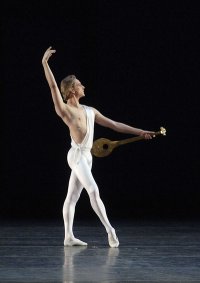David Hallberg, dancing with American Ballet Theatre / City Center, NYC / October 19 – November 6
When I first got addicted to ballet, type casting prevailed. The men naturally selected to play Princes (Swan Lake’s Siegfried, Giselle’s Albrecht) were as tall, handsome, and harmoniously proportioned creatures as a company’s roster could provide, their dancing a marriage of exactitude and flow. Management assigned these latter-day Greek gods Odette-Odiles and Giselles with matching attributes.
Demi-caractère dancers (more earthbound and/or more overtly virtuosic) were creatures of a decidedly different category and duly given other kinds of roles presumably suited to their anatomy and their gifts. Similarly, wiry, feisty young women with craggy faces, proletarian bodies, and technique that exposed rather than concealed ballet’s athletic base got to be the Cowgirl in Rodeo. There the model was the ballet’s choreographer, Agnes de Mille, who first played that leading role, which was, perhaps, a spiritual autobiography. De Mille’s most apt successor in that part may well have been Christine Sarry, an unforgettable dancer of similar physical type and style (though she had the additional attribute of projecting a tenderness that could make you cry). At ABT today, type casting is still evident—and, in many cases, wise. Erica Cornejo, one of the company’s most gratifying dancers, though the antithesis of the Swan Queen type, promises to be an ideal Cowgirl. (She gets her chance to prove her mettle in the revival of the ballet, slated for its first showing on opening night).
Way back when, dramatic dancers (emotionally charged in a Freudian rather than a poetic way—think Nora Kaye, dancing Tudor) made a third distinct category and, though casting occasionally broke these boundaries, often out of sheer necessity, they were for the most part respected. Times have changed, however, and dance-world customs with them, as is evident in David Hallberg’s wildly assorted assignments for American Ballet Theatre’s current season at the City Center. It’s hard to think of roles more disparate than the Poet in Fokine’s Les Sylphides, Death in Kurt Jooss’s The Green Table, and the title role in Jerome Robbins’s Afternoon of a Faun.

Hallberg is a natural for only one of these ballets—Les Sylphides. It was evident from the moment he appeared on the ABT scene in 2001, a beautiful blank, that he was born to play noble roles featuring lyrical dancing and melancholy yearnings. He’s a blond young prince—with a profile worthy of a Roman coin and a long, streamlined, exquisitely proportioned body—who has been schooled in a limpid classical style (to which the Paris Opera contributed as well as ABT). In the Fokine, where he plays the sensitive loner who wanders into a nocturnal glen haunted by gossamer visions, he’s absolutely prototypical.
No so for The Green Table, the ever-relevant antiwar ballet, where he takes the lead role of Death, who claims all participants. This devouring monster, who has a slithering, almost slimy quality to him, is a figure of tremendous authority and menace—like Voldemart, I explained to the kid slated to accompany me to a performance of the work. Death, in the Jooss ballet, is not merely a villain but a suprahuman force, and portraying him effectively calls for huge physical presence coupled with intense psychic energy. If you were type casting the role you’d hand it over without a second thought to Carlos Acosta.
Traditional European-sprung fairy tales, created long before the principles of political correctness affected our consciousness, employ a shorthand in which the hero is fair, the antihero dark. (It helps a prince’s case, too, if he’s conventionally handsome, the underlying idea being that beauty of a certain sort—every society, of course, creates it own singular model—indicates moral worth.) Other traditions have contributed to our instinct to associate dark coloring with sensual power. Thus an ideal male dancer in Robbins’s Afternoon of a Faun was the creator of the role, Francisco Moncion, whose looks bore witness to his Hispanic/Indian ancestry. Hallberg, on visual inspection a Nordic type, is in no way an obvious successor to this tradition. All he clearly has going for him is his remarkable beauty and an aloofness in appearance that will serve him well in conveying the narcissistic aspect of the young man who is so intent upon his reflection in the mirror of the ballet studio where the action is set. Embodying the more important erotic charge of the character will be a challenge to him. If he’s an imaginative artist, as I suspect he may be, the assignment could be revelatory. Needless to say, casting against the grain is educational for both performers and their fans.
David Hallberg will appear in Les Sylphides on October 20 & 30 matinee; in The Green Table on October 21, 25, & November 2; and in Afternoon of a Faun on October 22 matinee & 29 evening.
© 2005 Tobi Tobias



